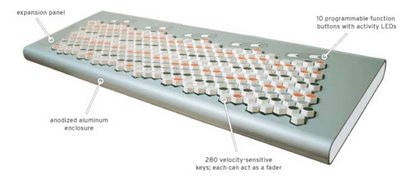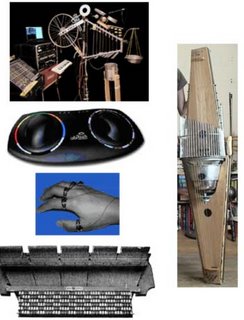 Composer/keyboardist/producer Elodie Lauten creates operas, music for dance and theatre, orchestral, chamber and instrumental music. Not a household name, she is however widely recognized by historians as a leading figure of post-minimalism and a force on the new music scene, with 20 releases on a number of labels.
Composer/keyboardist/producer Elodie Lauten creates operas, music for dance and theatre, orchestral, chamber and instrumental music. Not a household name, she is however widely recognized by historians as a leading figure of post-minimalism and a force on the new music scene, with 20 releases on a number of labels.
Her opera Waking in New York, Portrait of Allen Ginsberg was presented by the New York City Opera (2004 VOX and Friends) in May 2004, after being released on 4Tay, following three well-received productions. OrfReo, a new opera for Baroque ensemble was premiered at Merkin Hall by the Queen's Chamber Band, whose New Music Alive CD (released on Capstone in 2004) includes Lauten's The Architect. The Orfreo CD was released in December 2004 on Studio 21. In September 2004 Lauten was composer-in-residence at Hope College, MI. Lauten's Symphony 2001, was premiered in February 2003 by the SEM Orchestra in New York. In 1999, Lauten's Deus ex Machina Cycle for voices and Baroque ensemble (4Tay) received strong critical acclaim in the US and Europe. Lauten's Variations On The Orange Cycle (Lovely Music, 1998) was included in Chamber Music America's list of 100 best works of the 20th century.
Born in Paris, France, she was classically trained as a pianist since age 7. She received a Master's in composition from New York University where she studied Western composition with Dinu Ghezzo and Indian classical music with Ahkmal Parwez. Daughter of jazz pianist/drummer Errol Parker, she is also a fluent improviser. She became an American citizen in 1984 and has lived in New York since the early seventies
|
|
|
|
|

Sunday, May 10, 2009
Weird inventions and dawn of the Terpstra


Legend: top to bottom: Terpstra, Bikelophone, OrbiTouch, FingeRing (hand), Jankó keyboard, Bowafridgeaphone (right).
People have been inventing new instruments ever since the beginning of time, but it is almost frightening how lately people are thinking up alternatives to the ever-present keyboards we use: the piano keyboard and the QWERTY keyboard.
The OrbiTouch is a “keyless” keyboard that integrates the mouse and the keyboard According to the manufacturer, ““The orbiTouch creates a keystroke when you slide the two domes into one of their eight respective positions. You type the different characters by sliding the domes to create letters and numbers. The orbiTouch also has an integrated mouse, so moving the domes gives you full mouse and keyboard capability!”
The FingeRing is a wireless wearable keyboard invented by NIT Human Interface Laboratories in Japan. It is the prototype of a full-time wearable device for the input of commands and characters. A small accelerometer is worn on the base of each finger to detect the typing shocks generated by tapping the finger on any typing surface such as the thigh, knee or desk (called "finger-tip typing"). Commands and characters are generated from combinations of finger-tip typing actions. Each accelerometer is small and the finger-tip is not covered so they can be worn continuously in everyday life without trouble. In addition, no take-up action is needed for use, so immediate start of operation is possible.
I also found some weird musical instruments interesting: for the Bowafridgeaphone, instrument maker Iner Souster used refrigerator grates, violin bows, a broken old speaker, a cake pan, a metal salad bowl, and the few other spare pieces of metal. There are 36 strings along the body to help with its resonance, and pick up a few sympathetic tones; the Bikelophone, originally constructed in 1995, is a palette of sonic exploration, with magnetic pickups attached to amplify the sound, anything connected to the bike becomes amplified. The current configuration includes bass strings, scrap wood and metal, metal bowls, telephone bells, a mechanical foot pedal and a touch sensitive tone generator.Using a loop-based recording system and outboard signal processors (reverbs, delays, pitch shifts, etc.), sound compositions can include acoustics and electronics.
The Terpstra keyboard, brainchild of engineers/designers Dylan Horvath and Siemen Terpstra (in collaboration with artistic director Garnet Willis, advisor Joel Mandelbaum and executive director Reinhard) has been out of the box for a couple of years now, a full-capacity microtonal keyboard with a non-piano interface, i.e. 280 velocity-sensitive keys that can be assigned various micro-tunings with a maximum of 55 notes per octave. It is a control surface for microtonal music which requires a) software to run the tuning (such as Scala) but also b) a timbre module or sampler or sound library. I had a chance to play the Terpstra once and enjoyed the keyboard action as I didn’t find it difficult to adapt to the key layout and got some entertaining sounds out of it even though they weren’t pre-planned – you kind of have to move the hands vertically as well as horizontally.
For a keyboardist though it is a question of losing virtuosity at the piano keyboard in exchange for acquiring virtuosity on this unusual keyboard. Will the Terpstra, despite its undeniable creative possibilities and microtonal options, take off or will it be rejected by the players as was the Paul Jankó keyboard at the beginning of the 20th century – it offered a stack of six keyboards one above the other, which changed the entire action to make it more accessible to play with less of a stretch for the hand. And that was actually truly brilliant because for some people especially women with smaller hands, the stretch of the hand which barely goes to the 10th, precludes from playing material that requires very extensive chords as in Liszt, Scriabin, Rachmaninoff, etc.
The Terpstra has already found its enthusiasts: Aubrun Schect says “When a key is depressed, the entire change in position is monitored and translated to a very accurate and nuanced velocity by the time the key hits the bottom. Every key is easily re-mappable and if mapped to a continuous controller, then slowly depressing any re-mapped key sends out continuous data like a fader in real time. It does all of this with no latency.” Meanwhile, The Gizmodo web site calls the Terpstra "an instrument for musicians from another planet". We’ll see what the future holds, but I am eager to hear some of these new sounds.
posted by Elodie Lauten
2:12 PM
| |



